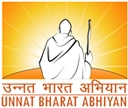FAQs related to Unnat Bharat Abhiyan
What is the name of the Scheme?
What is the official website and email ID of Unnat Bharat Abhiyan?
Who can join UBA?
I am a student, how can I be a part of UBA?
Is it mandatory for every Higher Education Institution to join UBA?
What are the eligibility criteria for joining Unnat Bharat Abhiyan?
- The college must be a Higher Educational Institution of India.
- The Higher Educational Institution must have an AISHE Code.
- The Higher Educational Institution should be willing to be involved in rural development activities.
- The Higher Educational Institution should be willing to identify at least 5 villages in their vicinity.
- The Higher Educational Institution should have at least 2 faculty members willing to be involved with development activities in rural areas.
- The UBA Joining application received shall be ranked on the basis of selection criteria setup by the ministry. The institutions that meet the eligibility criteria, will be selected under UBA.
What is the National Coordinating Institute (NCI)?
What is the role of the National Coordinating Institute?
What are the Subject Expert Groups (SEGs)?
What are the roles and responsibilities of Subject Expert Groups?
- To support PIs through a group of experts in their respective subject areas.
- Preparation of the compendium of relevant technologies.
- To evaluate the submitted proposals.
What is the Regional Coordinating Institute (RCI)?
What is the role of RCI?
What is a Participating Institute (PI)?
What is the role of the Participating Institute?
- The Participating Institute will adopt at least five villages in consultation with the District Collectors for the development activities under the UBA.
- Participating Institutions are expected to do field studies, study the implementation of the Government schemes, and facilitate their better implementation so that they meet their objectives best.
- PIs should engage interested faculties, students, NSS and other bodies of the institutes engaged in community activities.
- The selected PIs will work with State Government, district authorities / PRIs / other institutions and non-governmental bodies, for arriving at suitable solutions for improving the social and economic well-being of the rural communities.
Where can we find the UBA Survey App?
Does the UBA Survey App operate in offline mode?
Is there any UBA Project Management App for students and PI coordinators?
How can we generate additional funds (corpus fund/ convergence) in UBA?
- CSR Funds
- Alumnus Support
- Community Support
- Other relevant Government Schemes, etc.
What is the AISHE Code?
How to apply for Unnat Bharat Abhiyan in AICTE Quality Improvement Scheme (AQIS)?
What is Tech4Seva? Is it a part of UBA?
How is need analysis in Tech4Seva different from UBA?
Is there any Credit Framework for Internship under UBA?
| S.NO | Schedule | Duration | Activities | Credits | |||
|---|---|---|---|---|---|---|---|
| (Degree) | (Diploma) | (Degree) | (Diploma) | Degree/Diploma | (Degree) | (Diploma) | |
| 1 | Summer Vacation after 2nd semester | Summer Vacation after 2nd semester | 3-4 Weeks | 3-4 Weeks | Inter/Intra Institutional - Activites | 3-4 | 3-4 |
| 2 | Summer Vacation after 4th semester | Summer Vacation after 4th semester | 4-6 Weeks | 4-6 Weeks | Industrial/Govt/NGO/MSEME/Rural Internship/Innovation/Enterpreneurship | 4-6 | 4-6 |
| 3 | Summer Vacation after 6th semester | 6th semester | 4-6 Weeks | 3-4 Weeks | Industrial/Govt/NGO/MSEME/Rural Internship/Innovation/Enterpreneurship | 4-6 | 3-4 |
| 3 | 8th semester | 8th semester | 3-4 Weeks | Project work, Seminar (excluding credits for Advanced Courses) | 3-4 | ||
How are students benefitted by enrolling themselves into the UBA programme? OR How can students be motivated to get themselves enrolled under the UBA programme?
For example, with efforts done by IISER Thiruvananthapuram (RCI, UBA) all the Institutions affiliated to APJ Abdul Kalam Technological University will be eligible for awarding activity points, similar to NSS volunteers. Click for more details.
What is UBA 1.0 and UBA 2.0?




 E-MAIL
E-MAIL LANDLINE
LANDLINE



